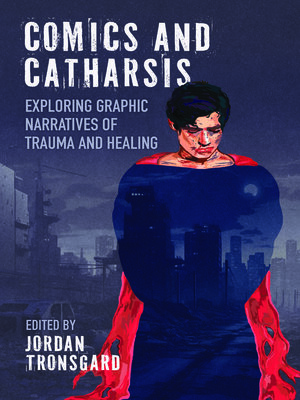
Sign up to save your library
With an OverDrive account, you can save your favorite libraries for at-a-glance information about availability. Find out more about OverDrive accounts.
Find this title in Libby, the library reading app by OverDrive.



Search for a digital library with this title
Title found at these libraries:
| Library Name | Distance |
|---|---|
| Loading... |
Contributions by Kelly Baron, Angie Chau, Jennifer Nagtegaal, Lee Okan, Diana Pifano, Russell Samolsky, Kay Sohini, Jordan Tronsgard, Anastasia Ulanowicz, and Aanchal Vij
Comics and Catharsis: Exploring Graphic Narratives of Trauma and Healing explores the idea that trauma and healing hold an imbalance in many forms of literature—especially in the world of comics. Whether it be war-based, national, physical, or sexual trauma, this volume looks at a wide variety of trauma and the psychological pain and devastation that arise during and—crucially for the question of trauma narratives—following the events as the psychological (and often physical) wounds are processed.
Essayists in the collection engage with questions of how comics process trauma through depictions and receptions. Viewing trauma through the lens of comics such as Maus, Persepolis, and Fun Home, as well as works by comics writers who are little known or unknown outside their communities, contributors analyze how trauma is used in artistic style, writing, and overall storytelling. Together, the essays in Comics and Catharsis show how people who have suffered trauma often flock to these works to find a way to acknowledge and process their own suffering.
Comics and Catharsis: Exploring Graphic Narratives of Trauma and Healing explores the idea that trauma and healing hold an imbalance in many forms of literature—especially in the world of comics. Whether it be war-based, national, physical, or sexual trauma, this volume looks at a wide variety of trauma and the psychological pain and devastation that arise during and—crucially for the question of trauma narratives—following the events as the psychological (and often physical) wounds are processed.
Essayists in the collection engage with questions of how comics process trauma through depictions and receptions. Viewing trauma through the lens of comics such as Maus, Persepolis, and Fun Home, as well as works by comics writers who are little known or unknown outside their communities, contributors analyze how trauma is used in artistic style, writing, and overall storytelling. Together, the essays in Comics and Catharsis show how people who have suffered trauma often flock to these works to find a way to acknowledge and process their own suffering.







